May 2 - 8, 2021: Issue 492
Michelle Cox And Sacha Jacobsen: Atelier 9
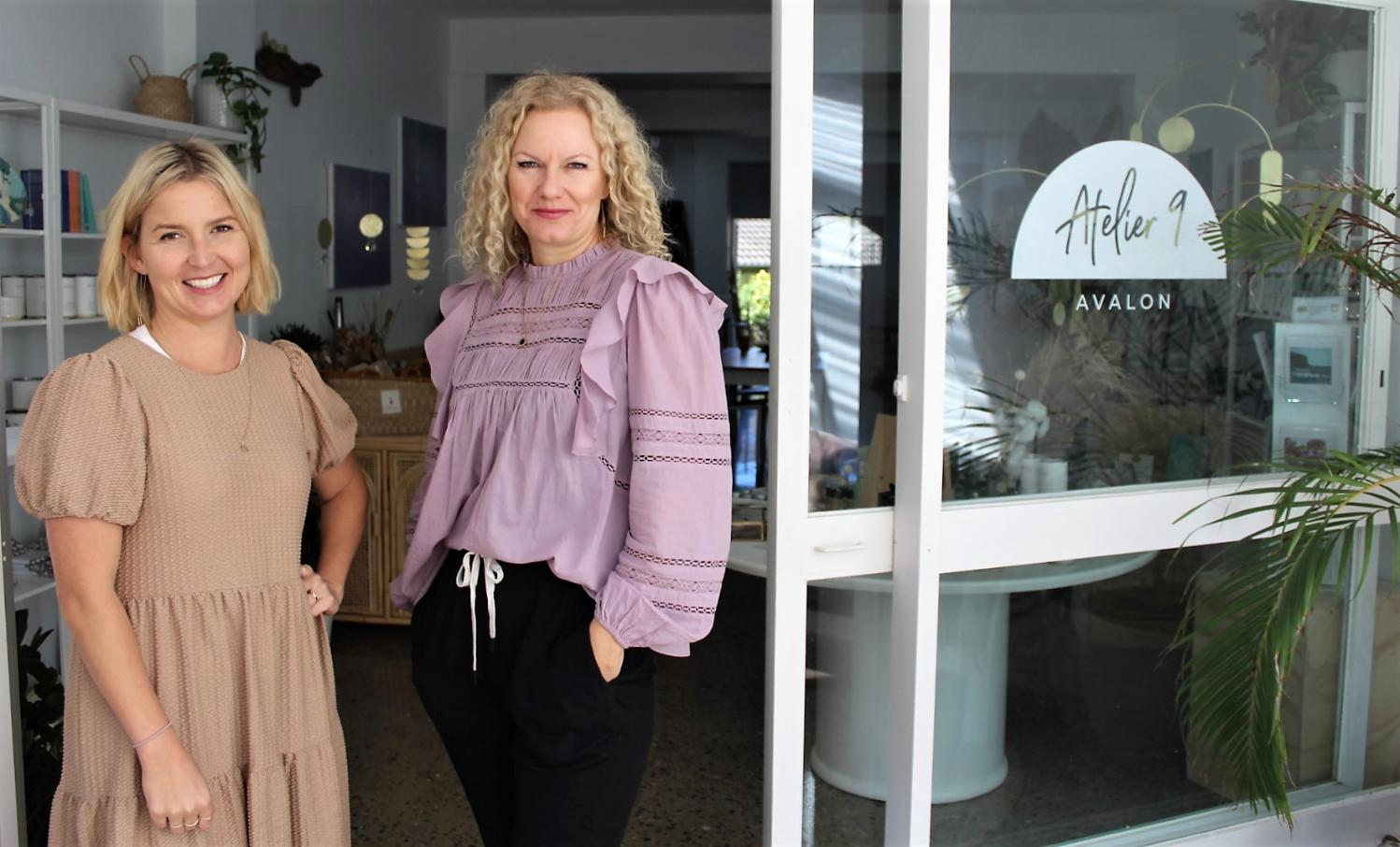
Insta updates: www.instagram.com/atelier9_avalon
Website: atelier9.com.au
The brainchild of Michelle Cox and Sacha Jacobsen, this 'makers studio' also curates a selection of amazing local brands and artists and runs as the Pittwater Online News May 2021 Artists of the Month.
Summa - 1/2 of Knox Cox Candle Co, was born in Broken Hill, and left to pursue a career in the Hair and Makeup industry. Moving around Australia for work, Summa spent years being involved in fashion events, photoshoots, television, education and even opened two salons.
Fast-forward a few years, Summa is married to Will and mum to three boys - Axel, Rocky and Jonny. Juggling family and work life, Summa and the family relocated to Pittwater, where her and best friend Michelle decided to build Knox Cox Candle Co. What started as a small passion project for friends and family is now an Australia-wide bespoke, luxury candle company. Five years on these hand poured 100% pure soy and coconut wax with cotton wicks specialities have a scent for every room and mood - including one called 'Palmie Life'.
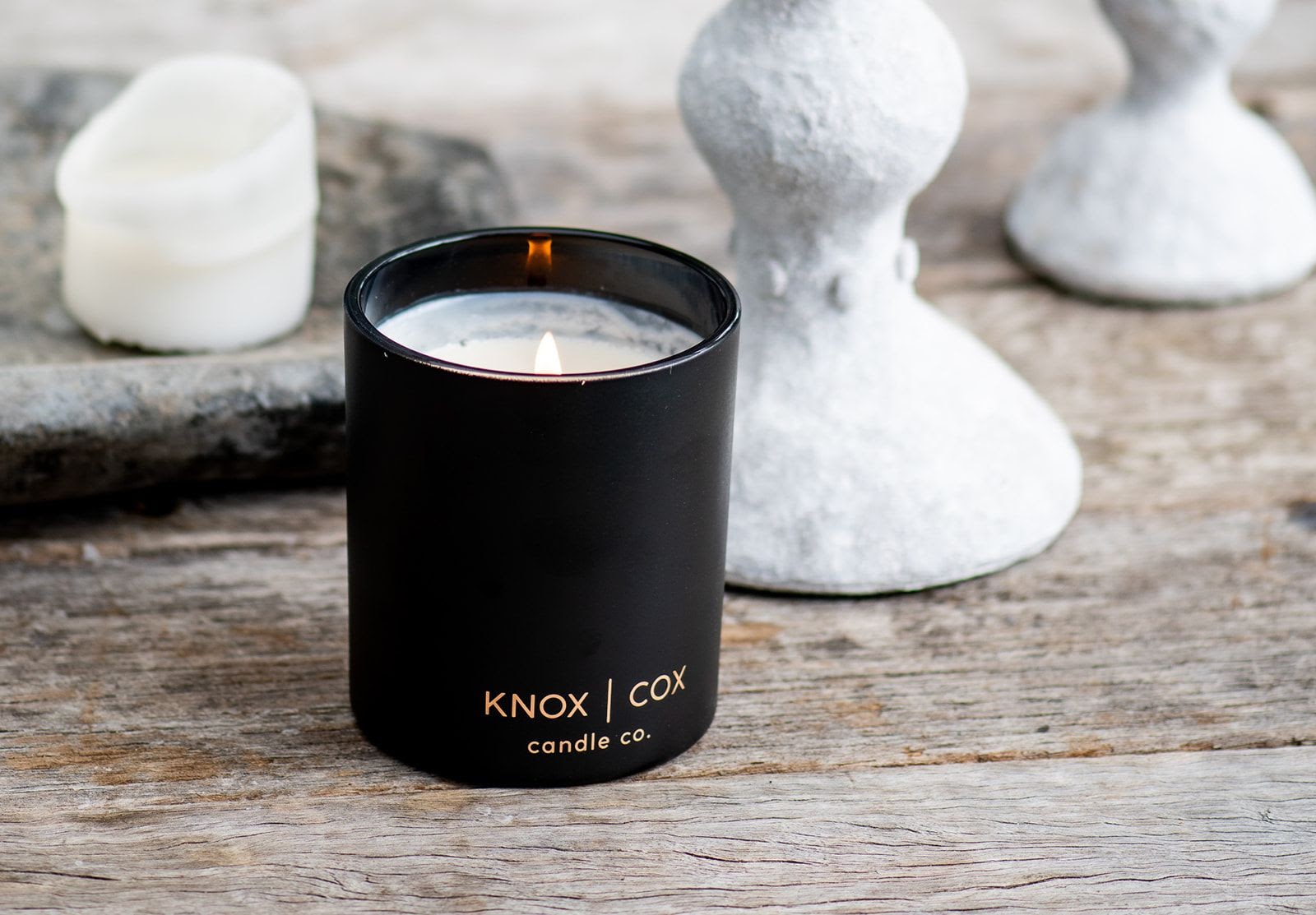
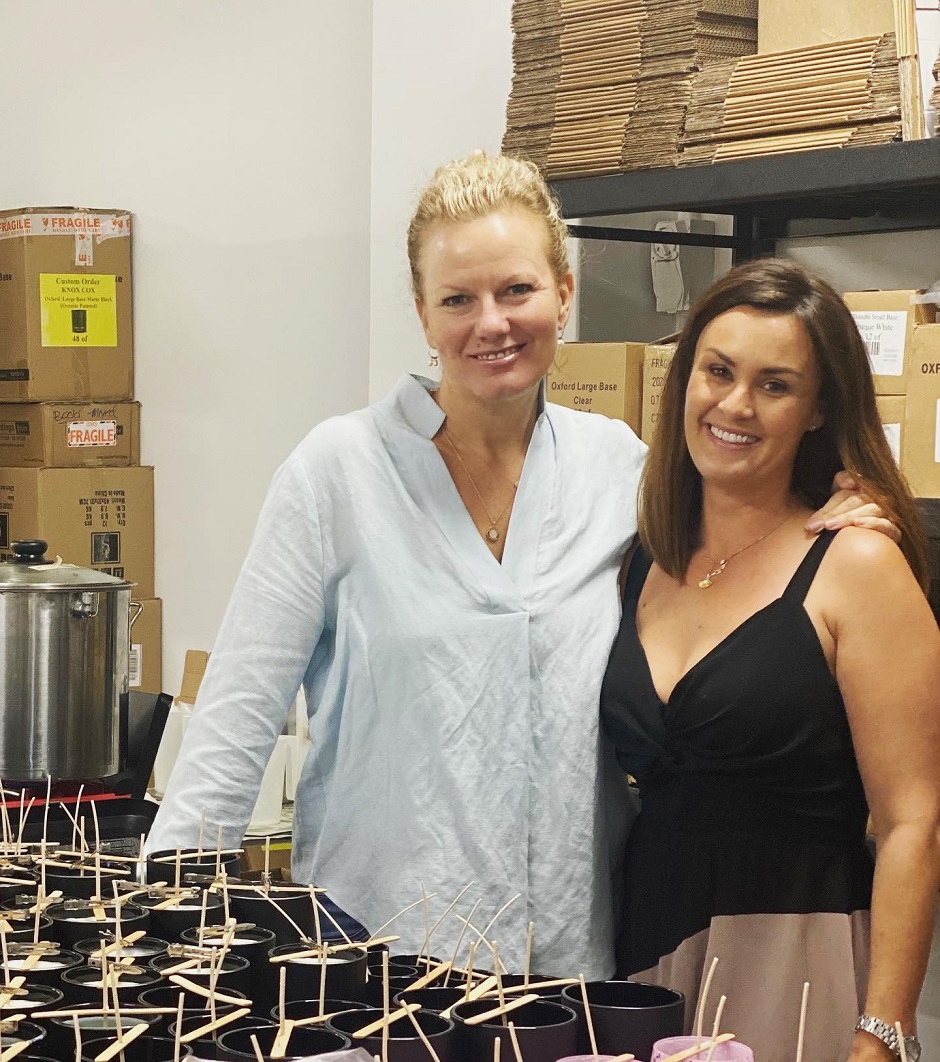
Michelle's career boasts a wealth of in-depth experience in a variety of National and Global Executive roles across a range of industry sectors. From business ownership, executive leadership, change management, culture creation, brand, product and all facets of marketing, she has demonstrated creativity, innovation and entrepreneurial ability in all of her career appointments.
Passionate about living an unconventional life and helping others to live a life that's right for them, Michelle recently wrote a book series and launched a podcast show in the same name - The Wabi Sabi Series. The books are short and impactful, centred around topics we don't often talk about. They can be found on Amazon, Booktopia, Apple Books, Barnes & Noble or www.wabisabiseries.com. The podcast centres around asking guests just one question - "If there was one thing you wish society would talk more about, what would it be and why?"
Sacha Jacobson, Juno + Ace, has three youngsters too. Her forte is making by hand amazing inly sculptural kinetic mobiles, sun catchers, wall hangings and jewellery.
''I'm very aware we need to take care of this planet, so I have partnered with Sendle, a carbon neutral delivery company for all Australian orders. I am very proud to say that my packaging is plastic free (with biodegradable tape) and I try to use sustainable brass wherever possible. So, you can rest easy that your new mobile or wall hanging won't cost the earth.''
This week a chat with two of these Creatives, Sacha and Michelle.
Where did the idea for Atelier 9 come from?
Sacha Jacobsen: Michelle started looking into this at first. I’d been working from home in my garage for a few years. Michelle was looking at ways to take her ceramics to the next level and so she contacted me and asked about my husband’s business, as he has a unit in town – so Michelle was curious about what he got that for and what the process for renting a space was and how that was working out. We had a little chat and I said ‘if you are going to get a space somewhere I’d be interested in being a part of that’.
Within a few weeks Michelle had found a couple of places for us to go and look at and this space at Careel Bay was the one we went with. Michelle had it sorted within a few weeks.
Michelle Cox: So Sacha and I and Summa had all been working in our businesses from home, in our garages and at our kitchen tables. Every small business gets to that stage where you know you’re ready to bite the bullet, expand the business and pay rent for a shopfront presence in your community. We felt if a few of us went in together we could actually, not only share the rent, but work as a collaboration and have a bit more fun – it’s quite lonely working at home as an Artist by yourself.
What is your background?
Sacha: I started making jewellery about 10 years ago. I’d finished Uni, was a bit lost and was working in my husband’s hospitality business. I then became pregnant and didn’t want to be on my feet making coffees all day anymore. I went and di a short course in making jewellery. When my son was born it was a bit tedious as they sleep all the time and so, to not get bored, as I like being busy, I ended up setting up and Etsy shop and from that the jewellery business just grew and grew. When we moved from the UK to Australia I evolved away from jewellery and started making bigger sculptural pieces using metal, as well as using brass and making homewares and selling these at design markets. I have been doing that for about 3 to 4 years now and doing that mostly from home – I did have a little studio in Mona Vale for a while but that didn’t suit what I was doing; so then we moved in here in October 2020 and commenced Atelier 9.
Michelle: My background is a bit different from that. I’ve been in the corporate world for the last 25 years, running large companies. I now call myself a ‘corporate gone creative’. So I still sit on Boards but about a year and a half ago I decided I wanted to do some different things as well. I had worked in tourism for 25 years and decided to start a little business called ‘Wabi Sabi Series Ceramics’. This was about embracing imperfection – I’m an A Type and like to do everything to the point of perfection or perfectly and this was a way of challenging myself as I got older to do that, to embrace imperfection. One way to do that was to start a business that would remind me of that every day.
I started with a series of books that I wrote. That led to a podcast and then that has come full circle. The essence of Wabi Sabi is a Japanese concept that actually stems from ceramics. I saw this beautiful dinner set at a market and thought ‘wow, if I buy every one of those pieces it’s going to cost me a fortune – why don’t I try and make one?’
I enrolled in a course at The Tramshed, at Narrabeen, and instantly felt like I’d done it forever, it was like coming home. I literally started just 18 months ago. Then of course, through the COVID months all the courses stopped. I decided it was time to buy my own wheel and this was actually my saviour throughout all the lockdowns and inability to travel – I just immersed myself in the work and sought out videos and information to expand what I was doing. I virtually completed an online course where I was watching YouTube videos and Instagram stuff. Since the lockdowns eased we started this business and I’m now getting commissions form all over the place, which is just fabulous.
Sacha – what drew you to jewellery initially and how did that evolve into sculpture?
Sacha: as mentioned, I was a bit lost and looking for something and then read ‘if you don’t know what to do think about what used to bring you joy as a child and adapt that’. I always used to love drawing and painting and making friendship bracelets with beads – anything creative. I thought ‘what’s the grown-up version of that?’
I’ve also always loved working with power tools – I’ve pretty much tried every craft there is; I’ve reupholstered chairs, woven, done woodwork – I like to get my hands dirty and jewellery was a combination of these. My dad’s a plasterer and my brother is a tradie as well, an electrician, but also a builder as well – so I come from a line of people who work in crafts with their hands. I thought I’d be happy doing this and on trying it out just instantly fell in love.
When we arrived here I went to my first design market; we have these in the UK but not on as big a scale, especially where I was in Brighton. I went to Sydney’s Finders Keepers and was just in awe of the size of the venue and the amount of people there and how they’d all set up their own 2x2 stalls – this was next level;.
I applied for one of these stalls and got in but thought ‘nah, there’s so much jewellery here, I need to be thinking outside the box and come up with something unique. I was having babies at the time, I have 3 children, so wanted to work in with that too and to work in metal.
I’ve also been a fan of mid 19th century Art, and Alexander Calder in particular, his stuff is just awesome, and Barbara Hepworth who does sculptures out of metal. I thought I’d have a go at a mobile and did some online research and made a few and it just went on from there.
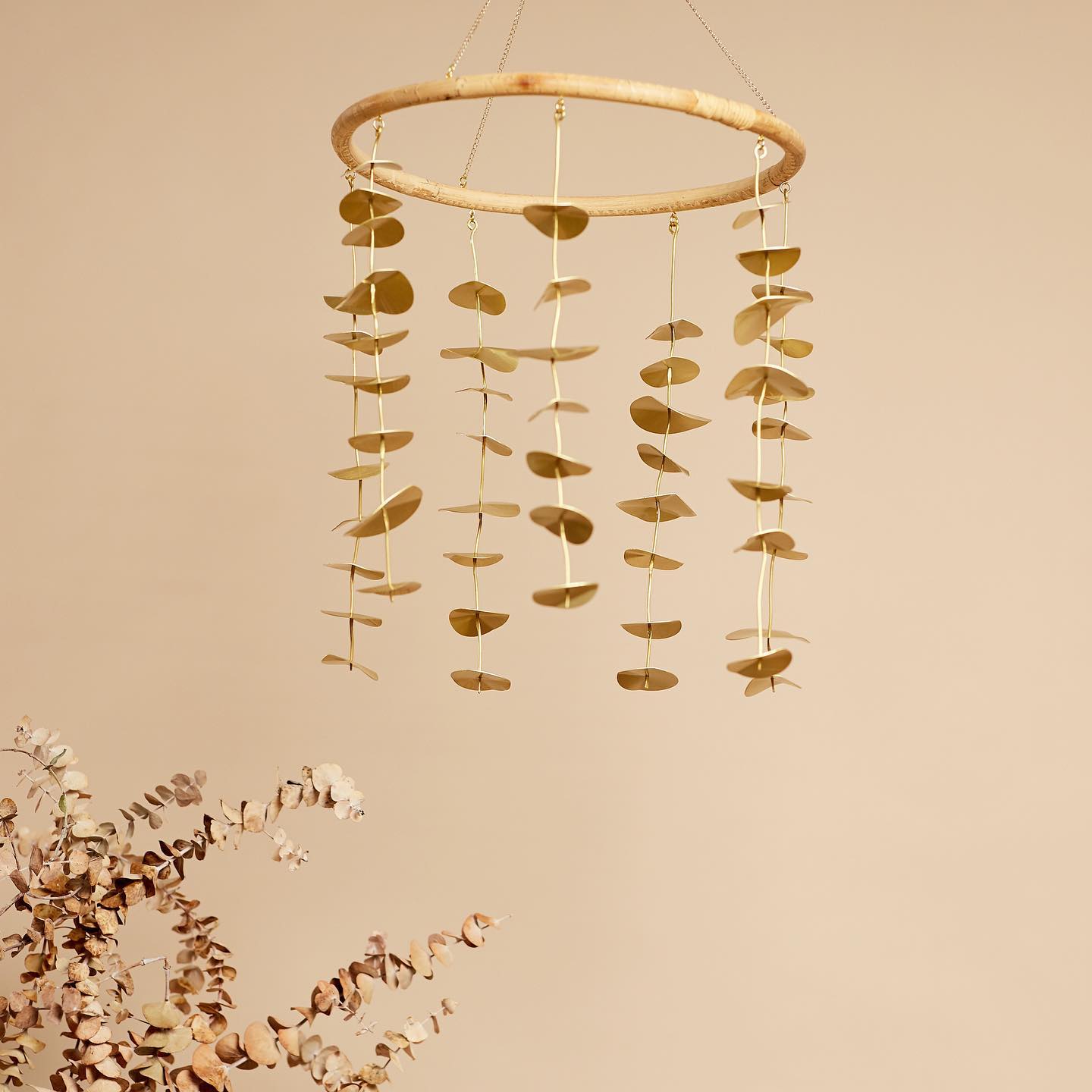
Rattan x Brass Eucalyptus Mobile - I love this piece, but it’s the most time consuming one to make! It has 56 small circles all hand sanded and bent to shape before being threaded onto their strand with the wire under each circle being hammered to keep it in place!
Michelle, what drew you to clay and ceramics?
My father was an engineer and had an interest in everything mechanical.my brothers are both tradies as well and mum was incredibly artistic too and I was an athlete. Mum was so good that I felt that everything I tried was not good enough so although I loved doing art at school and vaguely remember mum having a wheel, she passed away a long time ago, so I’ve always had a love for ceramics from early on. I love the tactile aspect of it and feeling you get through working with clay – that whole premise of making something from nothing really excites me. Having a piece of mud that literally comes form the ground and you mould it into something – that’s an exceptional experience. The frustrating as well as beautiful thing with pottery and clay is that the process that we go through. Sacha teases me all the time as she designs something and then makes it whereas every step of the way with ceramics something can go wrong.
This morning I have a whole commissioned order of plates in the kiln that I have been working on for two months, and this is the last step, firing them. I had a dream last night that the whole thing exploded; so it’s a bit nerve wracking, this last step, and so stressful hoping nothing goes wrong.
Ceramics teaches you patience, which has never been a virtue of mine – and possibly why I’ve been drawn to this work. I’m turning 50 this year, so to find something as a hobby that’s turned into a business has been a cathartic journey and at this stage and age in my life, I’m loving it, and its challenges. The contrast from going to a Board table and suits to being covered in clay has been a big change.
What is the concept, in general terms, of Wabi-Sabi?
It’s a Japanese philosophy. I spent a lot of time in japan through my travels for work and heard it many years ago and it resonated very strongly with me. It’s about embracing imperfection. It stemmed from generations ago when the original emperors had tea ceremonies, which would comprise hours of ceremony. They made these beautiful teacups to which they would deliberately add flaws to the glaze. The point of this was that when you were sitting there contemplating these cups and the imperfections, you become aware of the beauty within imperfection.
A lot of people now know of katsuki as well which is when you break a cup or smash a plate you can actually fix it with gold – and this is about the imperfection as well and appreciating the beauty within it and another form of pottery that stems from a Japanese cultural background.
It’s a beautiful concept and works really well for me in embracing imperfection in life, and especially with pottery, and it’s funny, the more my skills increase and the better I get at making pottery that’s good I find people don’t like those ones – they want the ones that are unique due to their flaws, their imperfections. Each piece is unique and although I am not as proud of these, these are the ones people want and love.
What artists have influenced your work?
Sacha: I grew up in St. Ives in Cornwall and there was a big movement of artists there from the West Country – we have a Tate Gallery down there which is a reflection of the art culture as this is a small region and you don’t normally get galleries of that calibre in small regions. My auntie used to run that Tate Gallery and also the Barbara Hepworth Museum, so I was influenced through her work. There is also a gentleman called Anthony Frost, son of Sir Terry Frost, and both father and son were abstract artists. The father (son?) would only paint circles and semi-circles, literally – they were his shapes. The son would only paint chevrons or a cone like shape. Because I worked in all the local restaurants they would have examples of these local artists works for sale in these and I would get to see them. They would be selling for thousands of dollars – these same shapes repeated over and over again in different colours and different ways and I think that subconsciously these influenced my work. I too love the circles and semi-circles and incorporate these into my work – I love the simple geometric shapes and how you can use these in a different combination to create something a completely different work and something unique.
Michelle – any influences outside of Wabi-Sabi?
Michelle: there is a German I’ve been following for a while, Malcolm Greenwood. Our first workshop has been run by him. We had him here for a 5 day Masterclass. Malcolm is one of Australia’s preeminent potters – a lot of his tableware is placed in big-name restaurants – so I’ve been following his work for quite a while and kept saying to a friend of mine that I’d love to meet him one day. She said, ‘sure, just come to his studio in Mosman’. I was a bit shy but worked up the gumption to inquire about a workshop he was holding in the Northern rivers area. Unfortunately that was all booked out. I asked to go on a waitlist and asked him if he was planning to do any workshops in Sydney. The reply was that he would love to but doesn’t have a space to teach. We did! We’d opened three weeks prior to that.
I went to meet him at Mosman and ended up staying for 6 hours just shadowing him in his workshop – and was fortunate to receive an invite to come back the next week and the next week to learn something more. I’ve learnt so much from Malcolm already – he’s so generous with his knowledge and does this is such a lovely way. To have mentored people in the corporate world and then to meet someone in the artistic world who does this or was prepared to help me was and is a benefice.
Potters are notoriously secretive about what they do and how they do it but I think this premier Australian ceramicist is at an age and a stage ion his work where he is prepared to share that knowledge. The techniques, and especially their glaze recipes are usually closely held – so learning how to do all these glazes has been a boon for me.
That workshop sold out in 24 hours. Malcolm comes from a Japanese school of learning sop his techniques are quite different to those we have already learnt from a British viewpoint and quite a revelation.
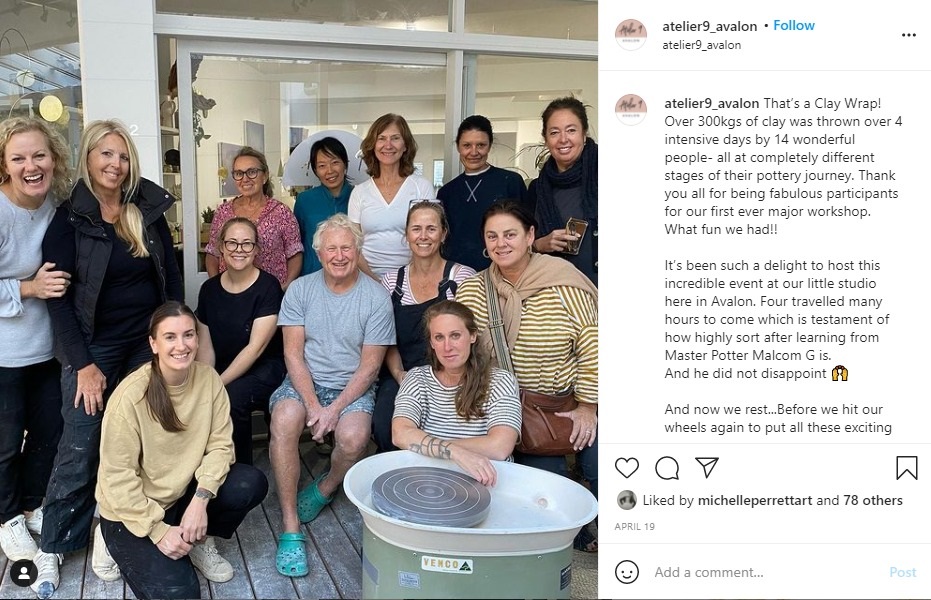
Are you going to be doing other workshops at Atelier 9 to share this passion?
Yes, lots on offer from local Artists:
POTTERY HANDBUILDING WORKSHOP
SATURDAY 8 MAY: 2 - 4.30PM $150pp
Playing with Clay has become so popular of late and it’s no wonder! Given the craziness of our world, there’s nothing more grounding than sinking your hands in a piece of the earth, making something creative with your bare hands that will likely last several lifetimes.
In this 2.5hour workshop, you will learn the basics of working with clay and will learn how to make a few small pieces like cups, bowls, spoons or small dishes. You will also be taught how to create textures on your pieces.
Your pieces will take a couple of weeks to dry, then will be fired twice, hand-dipped in a lovely milk-white glaze and ready for you to collect from the studio a few weeks after your workshop. The workshop pricing includes all tools and materials to make 3 pieces.
SCREENPRINTING WORKSHOP
SATURDAY 15 MAY 2 - 5PM $150pp
Show off your creativity at your next dinner party with your own set of napkins designed and printed by you. Join us for this fun intro to screen printing - learn a new creative skill and come away with something uniquely your own.
Learn to choose and prepare an appropriate design for hand-cut stencils. Then print your own design onto linen napkins using eco-friendly, water-based ink. This class covers the basics of screen printing onto readymade napkins and is suitable for those who have never screen printed before. Not only will you come away with a set of napkins featuring your very own design but also the know-how to start screen printing at home.
There’s also an Instagram page and website available to keep up to date with what will be coming up.
www.instagram.com/atelier9_avalon
You have a retail space here as well?
Michelle: yes, we could have just hired a factory space at Mona Vale but when discussing this we wanted to incorporate all these other local creatives for workshops as well as have an outlet for their works and products. We currently have around 14 local creatives products and artists here with everything from cards and ceramics and soaps and candles – all but 3 products comes from the Northern Beaches and the other 3 are from Byron Bay.
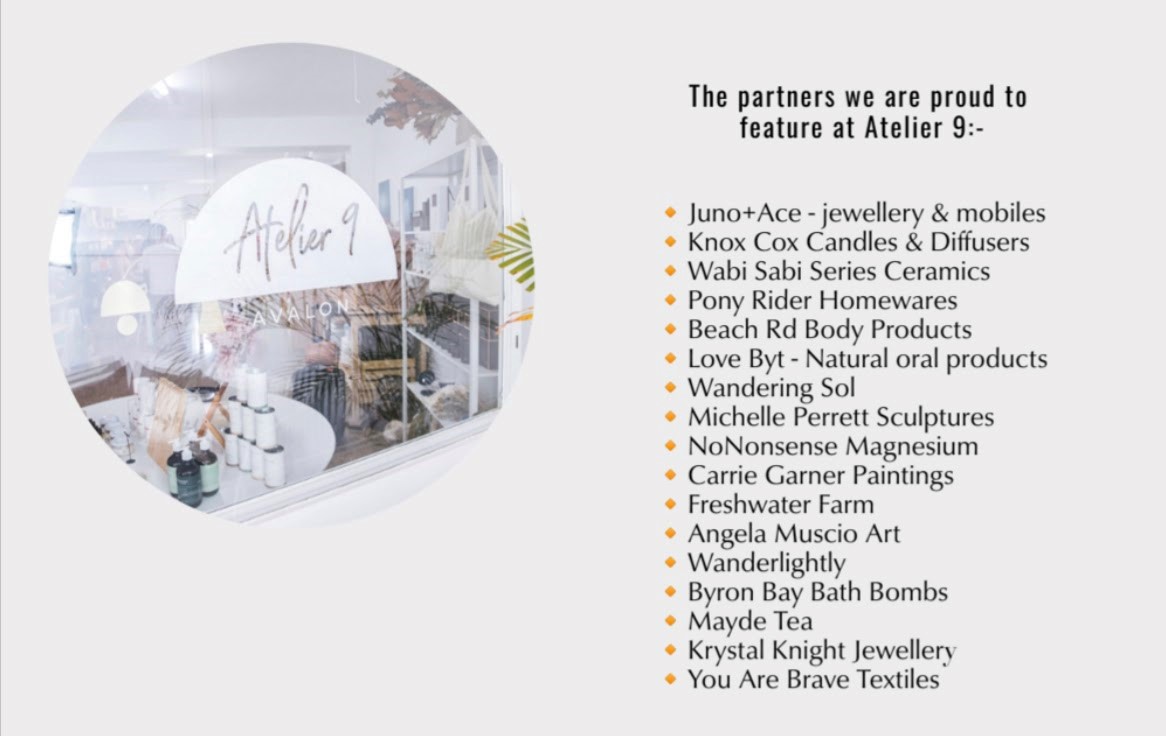
For us this is about stocking local products by local makers as that’s what it’s about. There is so much talent in this area and so many wonderful and unique items people can buy or give it seemed a natural match for what we’re doing.